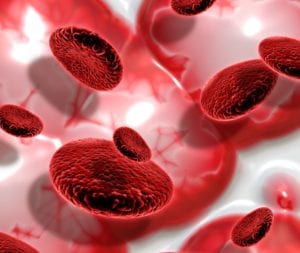Treating More Than Just Cancer
Did you know that 30% of the patients at Illinois CancerCare don’t have cancer? Cindi H. was surprised when she first found out. “I was so glad when I realized that the nice people at Illinois CancerCare were able to treat my iron deficiency anemia,” Cindi said. “Dr. Gerstner and the whole Illinois CancerCare team have taken such great care of me that I can’t imagine going anywhere else.”
In addition to treating patients who have blood cancers like leukemia, our world-class team also cares for people with blood disorders like erythrocytosis, sickle cell anemia and ITP.
Blood Disorders 101

Blood disorders include conditions that occur when there is a problem with any of the primary components of your blood. Each element has a specific responsibility and it’s our job to make sure they’re performing effectively:
- Red blood cells (RBCs) carry oxygen to the body’s tissues.
- White blood cells (WBCs) play the important role of fighting infections.
- Platelets are responsible for blood clotting to prevent excessive bleeding.
- Plasma is the liquid part of blood that carries blood cells, nutrients, waste, hormones and other substances.
In addition to extensive experience with disorders related to blood cells, our experienced hematologists and oncologists also have expertise for those conditions that affect bone marrow (the soft tissue inside your bones where blood cells are produced), and the lymphatic and immune systems. When there are abnormalities in any of these components or in related cells or tissues, it’s considered to be a blood disorder.
Blood disorders can be malignant (cancerous) or benign (non-cancerous). You may also hear them referred to as hematologic conditions. Today we’ll focus on some of the benign blood diseases we treat at Illinois CancerCare (ILCC).
Low Blood Cell Counts
When blood cells don’t form or mature as they should, they can’t carry out their normal functions. This overview introduces you to the types of disorders that occur when your RBCs, WBCs or platelets are at sub-par levels.
If you have low levels of red blood cells, you may have one of the following types of anemia:
- Anemia of Chronic Disease: Caused by a long-term infection or an inflammatory disease like rheumatoid arthritis or ulcerative colitis, this type of anemia is treated by focusing on the original disease that caused the reduction in RBCs.
- Iron Deficiency Anemia: This is the most common type of anemia and is caused by insufficient iron due to diet, changes in health, gastrointestinal problems or blood loss. Iron is used to form hemoglobin which resides in red blood cells to deliver oxygen throughout the body.
- Sickle Cell Anemia: While normal RBCs are smooth and round, in sickle cell anemia the cells become hard, sticky and shaped like sickles (crescents). Instead of gliding easily through the blood vessels, these sickle-shaped cells get stuck causing blockages, damage, pain and anemia. These RBCs die quickly and your body can’t generate enough new cells to compensate.
- Aplastic Anemia: When bone marrow is damaged it can shut down, resulting in too few RBCs, WBCs and platelets. Causes may include an autoimmune disorder, parvovirus infection, radiation exposure, toxins and chemotherapy.
A reduction in the number of white blood cells is called leukopenia. When a person has an infection or is dealing with inflammation, their WBCs typically increase to fight the infection. In some cases, however, the infection itself can destroy white blood cells. In other cases, the WBCs are reduced by an autoimmune disease, bone marrow disorder or certain medications.
A low platelet count may indicate one of two types of thrombocytopenia. Both elevate your risk for uncontrolled bleeding:
- Immune Thrombocytopenic Purpura (ITP): This is an autoimmune disease, in which your body attacks and destroys platelets.
- Thrombotic Thrombocytopenic Purpura (TTP): This rare blood disorder occurs when small clots are formed within the bloodstream. These clots destroy the platelets and can lead to anemia since your body is unable to generate RBCs faster than they’re eliminated.
High Blood Cell Counts
Our bodies require a delicate balance of our blood cells. Let’s look at what happens when you have too many RBCs or WBCs.
When your bone marrow makes too many RBCs (also called erythrocytes), you have erythrocytosis. The most common type of erythrocytosis is polycythemia vera, in which the excess blood cells may cause blood clots, heart attacks or strokes.
An abundance of WBCs is known as leukocytosis. The increase in white blood cells is often the body’s way of fighting infection or inflammation. When the source of infection or inflammation is resolved, the WBCs should go back to normal. If they remain elevated, one of our hematologists will help determine the underlying cause.
Other Blood Concerns
In addition to the disorders related to the relative quantity of various types of blood cells, other concerns include deficiencies of important substances like clotting factors (hemophilia) or unwanted items like abnormal proteins (in amyloidosis). We are well-equipped and well-staffed to diagnose and treat these conditions so you can live your life to the fullest.
With so many different types of blood diseases and cancers, it’s smart to choose a team like ours that has a deep bench of experience across the spectrum of blood disorders. And because we have clinics in 12 locations, you can receive compassionate care close to home. If you’d like to learn more, please visit the Blood Disorders Page.



